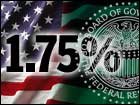|
Fed leaves rates alone
|
 |
January 30, 2002: 2:56 p.m. ET
U.S. central bank ends one of the most aggressive cutting campaigns in history.
|
NEW YORK (CNN/Money) - The Federal Reserve decided on Wednesday to leave short-term interest rates unchanged, ending one of the most aggressive rate-cutting campaigns in the U.S. central bank's history.
Fed policy makers ended their two-day meeting by announcing that they were leaving their target for the federal funds rate, an overnight bank lending rate, at 1.75 percent, the lowest level since 1961. The Fed also left unchanged the seldom-used discount rate.
In the statement announcing its decision, closely read by analysts for clues about the future of monetary policy, the Fed said it thought the risks to the economy were still weighted mainly toward weakness, meaning it could cut rates again if the economy suddenly takes a turn for the worse.
But it was also a considerably more optimistic statement than other recent rate decisions.
|  | |
 |
 |
 |
| |
 CNN's Tim O'Brien from Washington on the Fed's decision to leave rates unchanged.
CNN's Tim O'Brien from Washington on the Fed's decision to leave rates unchanged.
| |
 |
"Signs that weakness in demand is abating and economic activity is beginning to firm have become more prevalent," the Fed said. "With the forces restraining the economy starting to diminish, and with the long-term prospects for productivity growth remaining favorable and monetary policy accommodative, the outlook for economic recovery has become more promising."
U.S. stock prices were at first mixed after the Fed's announcement, but later rose as some corporate accounting fears eased. Treasury bond prices fell.
Most economists and Wall Street analysts were expecting the Fed to leave rates alone, especially on the heels of Wednesday morning's report by the Commerce Department that U.S. gross domestic product (GDP) actually grew in the fourth quarter, surprising analysts who expected it to shrink.
"This action really reveals the Fed's excitement with the emerging signs of economic growth we're seeing," said Anthony Chan, chief economist at Banc One Investment Advisors.
Click here for more on the Fed and rates
The positive quarter helped the economy avoid two straight quarters of shrinking activity, the common definition of recession. Still, economists at the National Bureau of Economic Research, which defines recessions by different criteria, said a recession began in March and was worsened by the Sept. 11 attacks.
To keep consumers spending even as the unemployment rose and the economic situation worsened, the Fed cut short-term rates 11 times in 2001, a record for a calendar year. Early in 2002, Fed Chairman Alan Greenspan and several other Fed officials made comments that gave the impression that they might have to cut rates again to insure the economy recovered.
But recent data have shown a stabilization in new weekly jobless claims, the manufacturing sector and in the sentiment and spending of consumers, who fuel two-thirds of the U.S. economy.
Last week, Greenspan told Congress he thought a recovery was imminent and even backtracked from the gloomier statements he made earlier in the year. Most economists took that as a sign that the Fed's rate-cutting campaign was likely over.
Less clear, however, is what the Fed will do next. Many economists think it will actually start raising rates again later this year, once it's clear that the economy is recovering, in order to keep inflation in check.
On the other hand, the economy still faces considerable headwinds. For one thing, consumer spending is unlikely to get the boost it usually gets after recessions. Consumers have kept spending all along, and they've accumulated significant levels of debt in doing so.
Also, it's still difficult to tell how much business spending will pick up. A sudden drop in business spending following the boom of the late 1990s led the current economic downturn, and demand for new production equipment, including new technology, won't pick up until businesses are sure there's matching demand for new goods.
"The degree of any strength in business capital and household spending...is still uncertain," the Fed acknowledged.
Falling stock prices helped fuel the latest recession, and stocks have struggled to gain any ground in recent weeks, despite a widespread belief among investors that the recession will soon be over. If slumping corporate profits and equity prices continue to cut into consumers' balance sheets, they may be less inclined to spend. The ever-unfolding Enron Corp. disaster doesn't do much for confidence in stock prices or corporate profits, either.
Implied yields on fed funds futures contracts, usually an excellent predictor of Fed rate activities, anticipate that there's about a 50-percent chance of the Fed raising rates again at its May 7 policy meeting. Many economists, however, think the next rate hike will come much later.
"Robust growth probably won't get going until the second half of the year," Merrill Lynch chief economist Bruce Steinberg said. "The first tightening move by the Fed is unlikely to occur until late summer at the very soonest." 
|
|
|
|
|
|

|

